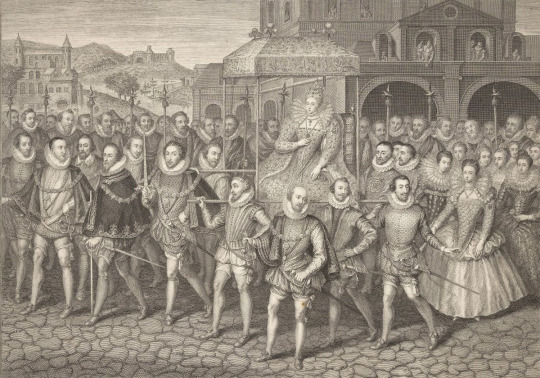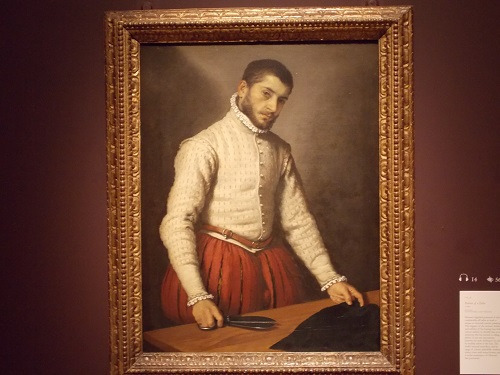#netherstock
Explore tagged Tumblr posts
Text
Let's Talk Costuming: Come on, Hamlet! Buck up!

Welcome, my friends, to the Renaissance, or to be more specific in geography and time, the Elizabethan period! Shakespeare! Protestantism! Great fun! For context, this scene likely takes place sometime around 1599-1601, towards the end of Queen Elizabeth's reign.
What I find most interesting about clothing of this period (aside from how silly looking some of it is) is that this is the era of ~*sumptuary laws*~ so every piece of clothing you see tells you a story about the person wearing it! Of course, I can't imagine Crowley or Aziraphale are all that concerned with being mistaken for a duke or somesuch, but it's fun to image what an onlooker may have thought of them.
Note: The focus of this analysis will be on Aziraphale's costume and on Elizabethan sumptuary laws. Crowley is up next, and his costume analysis will focus more on composition.

[text of a Royal Proclamation dated 15 June 1574, British Library]
Sumptuary laws have been around for a while, and they served a dual purpose during the Elizabethan period. First and foremost, they set to reinforce class boundaries by forbidding one to dress above ones station, but they also sought to reduce foreign imports of excess frippery that drained English pocketbooks. The proclamation even warns that young men of the realm, having spent their fortunes on fine clothing, will turn to lives of crime to satisfy their appetites.
These laws regulated all kinds of things: the textiles one could wear, in what colors, how much a guy could pad his calves out for ultimate sex appeal, really anything you can think of. That's not a joke, in fact a man in 1565 was detained for wearing "a very monsterous and outraygous greate payre of hose," which likely refers to a 1562 regulation on hose, ruffs, and swords. Hose could not be "containing in the netherstocks and upperstocks more than one yard and a half, or above one yard and three-quarters at the most, of the broadest kersey, or with any other stuff beyond that proportion," nor could they be lined excessively or constructed with too much fabric.
This same law regulated ruffs, like the ones we see at Aziraphale's neck and sleeve cuffs, to only a single width of ruffle, which dear Azi is following:

Where he might find himself in a spot of trouble, though, would be in the colors he's wearing. The color combination is rather divine on him, but the use of gold embroidery on clothing is forbidden unless one ranks as a Viscount or above. Now, could it be argued that Aziraphale, as an angel and a principality, has a privileged rank of his own? Yes, it could, but that takes some of the fun out of this.
His doublet (cute little jacket) appears to be a silk damask dyed in a lighter shade of blue, so likely woad. He would be safe in all these regards. Were the blue indigo, he could get in trouble for that, however, as that rich shade of blue was reserved for the upper echelons of the gentry as well.
Swords notwithstanding, the cut of Aziraphale's garments is reminiscent of several of the gentlemen in the foreground here:

[Royal procession of Queen Elizabeth. Printed by and for J. Nichols and Son, London, 1823. Folger Shakespeare Library]

As usual, we see Aziraphale in a tasteful iteration of the era's clothing that incorporates his character's color scheme. The incredibly dramatic silhouettes of the era definitely leave their mark, but he ends up looking rather refined rather than ridiculous.

[The Tailor, Giovanni Battista Moroni, 1565-1570]
This portrait gives a great view of these outrageous pants up close, as well as a jacket very similar in design to the one Aziraphale wears in this scene. The primary difference between the two is that the tailor is dressed appropriately for a craftsman, plain colors and not much extraneous ornamentation. Against this, Aziraphale certainly stands out, with his fancy trims and such, and would thus necessarily be identified as a member of the gentry by anyone in his vicinity.
This is important, because his positionality in this world is very clear. As in many of our historical moments, Aziraphale's wish to blend in only extends to a certain degree. He complies with the style of the era, and I suspect even enjoys his little games of dress-up, but as time goes on he creates more distance between himself and the garb of the peasantry. In some of the biblical era flashbacks, he's dressed rather plainly, but in later periods we seem him as a knight, a rather foppish Victorian gentleman, and finally in his well loved 20th century gentleman outfit that he keeps well past the point of anachronism.
He leans into these little luxurious identities in part because he is an angel, yes, but he is also slowly falling in love with all the beautiful little things that humanity has to offer. And what does the renaissance give him? Great works of theatre, luxurious gold embroidered silk jackets, and slutty little pumpkin shorts.

He's adorable, you have to admit. My sources, for your further reading pleasure or to prove I did my research:
-https://blogs.loc.gov/law/2014/02/sumptuary-laws/
-https://www.bl.uk/collection-items/proclamation-against-excess-of-apparel-by-queen-elizabeth-i#:~:text=During%20the%20reign%20of%20Queen,on%20luxuries%20such%20as%20clothing.
-https://www.folger.edu/blogs/shakespeare-and-beyond/sumptuary-laws-rules-dressing-shakespeare-england/
Ta ta, have a wonderful day, and I hope you enjoyed our little history lesson.
#good omens analysis#costume design#history#clothing history#good omens#good omens costumes#historical clothing#aziraphale#aziraphale good omens#michael sheen#I spent eight hours in the library today writing a paper why did I come home and spend another two hours researching this
152 notes
·
View notes
Note
Hey! In which way were men & women hunting clothes different from court clothes in the times of Henry VIII and Anne Boleyn? I suppose they were more practical, like tighter sleeves for the ladies instead trumpet sleeves? What about their headgear? And while going for practical, perhaps there were also some jewel ornaments here and there bc it always was about showing how rich u are? I watched some hunting scenes in Wolf Hall but Anne's dress looks like ... Too medieval? (I cant remember well, where H&A recreating Robin & Marian? Both in green with arrows). Do we have images of Tudor/Henrician hunting clothes? Thanks.
Women wore riding habits and 'safeguards' if they were riding without them, to protect their gowns from any dirt. Queens carried whips, 'ryding roddes', alone or in bags, such as 'a bagge of blue buckram with ryding roddes'.
Livery was provided for servants of the hunt, hose was set to be green, probably for better camouflage, and double-soled shoes for relative silence in pursuit.
The great wardrobe accounts of Henry VIII number 'hunting shoes', 'hunting spurs', 'hunting coats' (also usually green, likely for the same reason), 'riding cloaks', 'riding coats', 'riding bonnets', 'riding caps', 'riding hoods', 'hunting gloves' (one, made from doe skin), 'hawking coats' and 'hawking gloves' (one, embroidered with damask gold).

Henry VII owned 'riding gowns' of 'crimson and black velvet' and one of 'purple velvet with libards'.
Prince Arthur owned a 'riding gown of crimson velvet furred with martens' & 'a riding hood of black satin lined with black velvet'.
Anne Boleyn once gifted Du Bellay a 'hunting coat and hat'. Henry VIII gifted her shooting gloves and a bracer to guard her wrist(s), saddle(s) 'of the French fashion, with a pillow of down covered with black velvet' and 'Spanish leather', 'saddle hose' (if I had to guess, 'boot hose', 'stocking worn inside boots to protect the netherstocks', or this is just another word for reins), and "pillion saddles for [them] to ride out together'.
Boots and spurs were worn by men for riding. One example of the former were 'brown skin deerskin thigh high boots, cut from one piece of deerskin and pinked (scalloped) for ease of movement, seamed up the back of the leg and shaped at the calf and the knee'.
'Buskins' seem to be the type of boots worn primarily by women:
"knee-high, pull-on boots with a turned down top, often with lacing for fastening, made from both leather and silk"
Henry Fitzroy owned riding coats and cloaks of scarlet, black, crimson, green, and purple, made from cotton, frisado (a heavy worsted cloth), satin and taffeta.
Thomas Cranmer owned a 'short riding jacket of worsted lined with cotton'.
There were also whistles made for luring a falcon or hawk back to its owner's glove.
Sources:
Hayward M. (2007). Dress at the court of king henry viii.
Guy J., Fox J. (2023). Hunting the Falcon.
5 notes
·
View notes